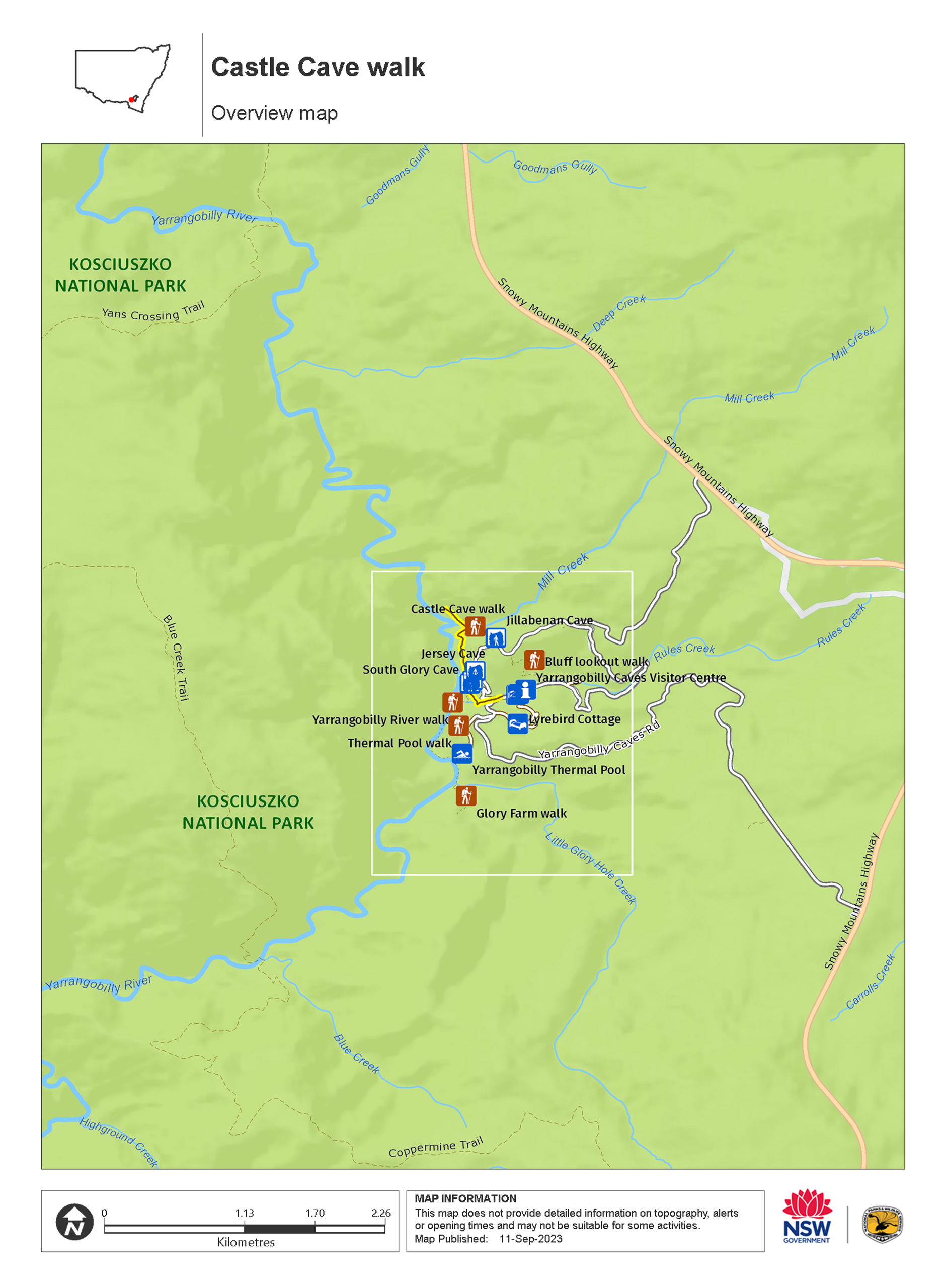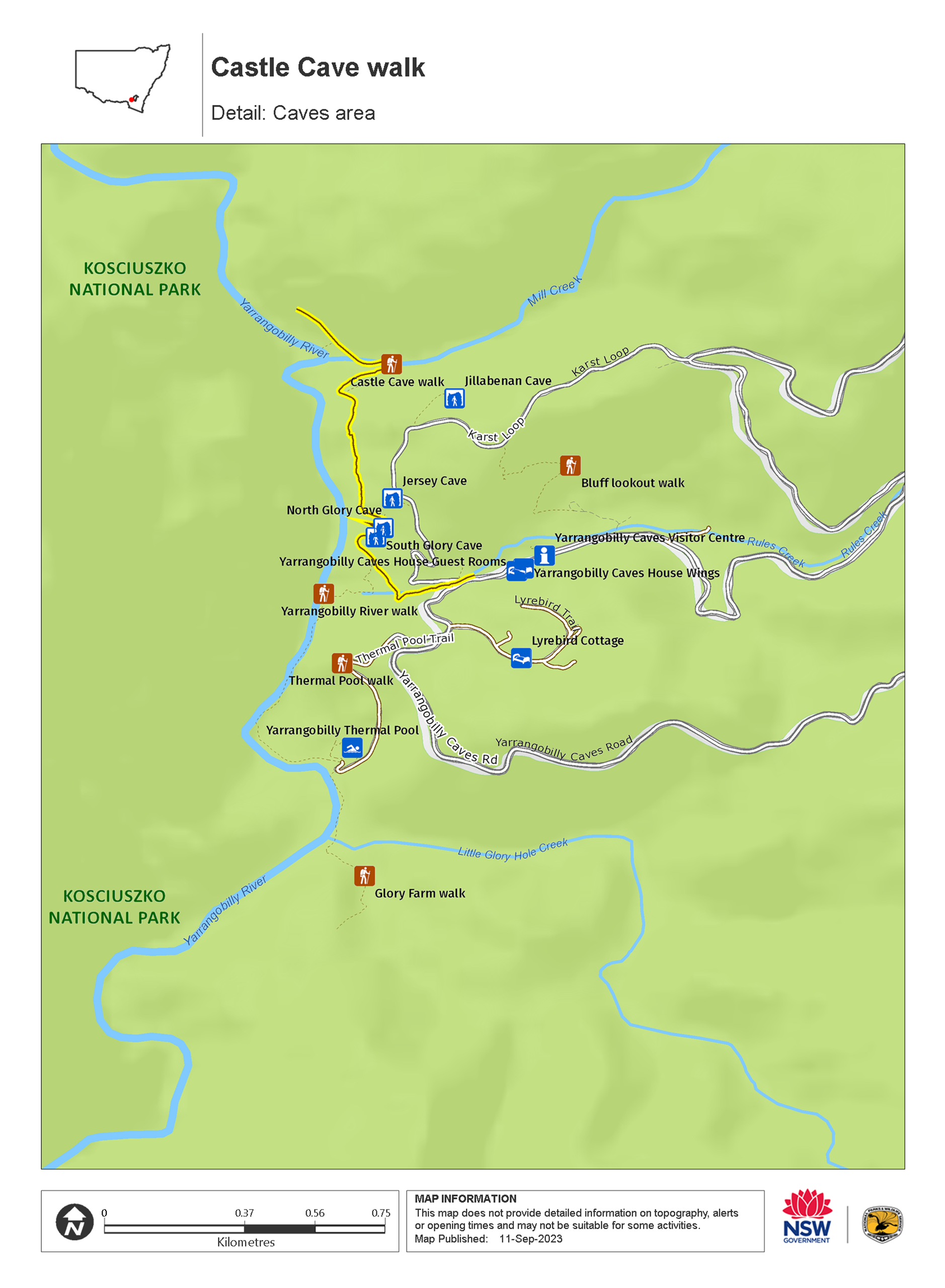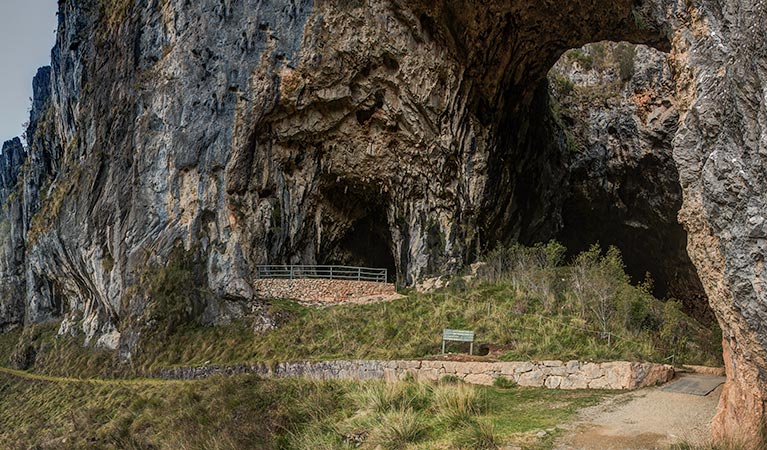Overview
Castle Cave walk is a short, scenic walking track at Yarrangobilly Caves. It's easily combined with a cave tour, summer fishing or birdwatching, in northern Kosciuszko National Park.
- Distance
- 3.2km return
- Time suggested
- 45min - 1hr 15min
- Grade
- Grade 2
- Entry fees
- Park entry fees apply
- What to
bring - Drinking water, hat, sunscreen
- Please note
- For guided and self-guided tours of caves, you’ll need to buy tickets before you start the walk at Yarrangobilly Caves Visitor Centre.
This inspiring walk for photographers, birdwatchers and bushwalkers, starts from Glory Cave carpark at Yarrangobilly Caves. Follow the path above the Yarrangobilly River, passing Glory Arch and South Glory Cave, as you head towards Castle Cave.
Along the way you'll see dry stone walls, built from hand cut limestone in days past. Continue below spectacular limestone cliffs until the track veers left to Mill Creek Gorge, and on to Castle Cave.
Ask the Yarrangobilly Caves Visitor Centre about guided tours through Castle Cave, before you start the walk. South Glory Cave is open year-round for self-guided tours, and makes a great detour as you head back along the track. You'll need to buy tickets for all caves from the visitor centre.
In warmer months, why not extend your walk to visit the Yarrangobilly River and Thermal Pool. Enjoy fishing and swimming in the pristine mountain waters, while the currawongs and kookaburras chatter in the trees. Winter often blankets the area in snow and offers the chance to see glistening icicles clinging to the South Glory Cave entrance.
With overnight options at nearby historic Yarrangobilly Caves House and Lyrebird Cottage, you might be tempted to linger a while in the magnificent high country.
Map

Map

Map legend

Local alerts
For the latest updates on fires, closures and other alerts in this area, see https://www.nationalparks.nsw.gov.au/things-to-do/walking-tracks/castle-cave-walk/local-alerts
General enquiries
- National Parks Contact Centre
- 7am to 7pm daily
- 1300 072 757 (13000 PARKS) for the cost of a local call within Australia excluding mobiles
- parks.info@environment.nsw.gov.au
Park info
- in the Yarrangobilly area of Kosciuszko National Park in the Snowy Mountains region
The Yarrangobilly area is open all year. See individual show caves and guided tours for times and prices. Additional tours run during NSW school holidays. Contact Yarrangobilly Caves on (02) 6454 9597 to confirm the tour times for your visit.
-
Park entry fees apply in the Yarrangobilly area
$4 per vehicle per day applies at Yarrangobilly Caves for motor vehicles without a Kosciuszko National Park day pass or NPWS All Parks annual pass.
See vehicle entry fees for other areas in Kosciuszko National Park.
You’ll need to buy a ticket or cave pass from the Yarrangobilly Caves Visitor Centre to visit all Yarrangobilly’s caves.
Buy annual pass.
Visitor info
All the practical information you need to know about Castle Cave walk.
Track grading
Features of this track
Distance
3.2km return
Time
45min - 1hr 15min
Quality of markings
Clearly sign posted
Experience required
No experience required
Gradient
Gentle hills
Steps
Occasional steps
Quality of path
Formed track
Getting there and parking
Get driving directions
Castle Cave walk is in the northern precinct of Kosciuszko National Park. To get there:
From the Monaro Highway:
- At Cooma, take the Snowy Mountains Highway and continue for approximately 110km
- Turn left into Yarrangobilly Caves Entrance Road
- Follow the unsealed road for approximately 6km to Yarrangobilly Caves
- Castle Cave walk begins near Yarrangobilly Caves House.
From the Hume Highway:
- At Gundagai, take the Tumut exit and follow Gocup Road to Tumut
- Continue on Snowy Mountains Highway south for approximately 75km
- Turn right into Yarrangobilly Caves Entrance Road
- Follow the unsealed road for approximately 6km to Yarrangobilly Caves
- Castle Cave walk begins near Yarrangobilly Caves House.
Road quality
- Yarrangobilly Caves entrance and exit roads are graded gravel. They're suitable for 2WD and 4WD vehicles up to 12.5m in length, however the Roads and Maritime Service (RMS) advise that the roads are unsuitable for caravans.
- RMS recommends snow chains are carried by all vehicles driving in the park in winter, including 4WD and AWD, in case of extreme weather. Visit the Live Traffic website for road conditions.
Parking
Parking is available at Glory Cave carpark. Please note park entry fees apply for vehicles without a Kosciuszko National Park day pass or All Parks annual pass.
Bus parking is available – contact the visitor centre on 02 6454 9597 for access.
Facilities
Toilets and picnic facilities are located at nearby Yarrangobilly Caves Visitor Centre.
Maps and downloads
Prohibited
Drones
Flying a drone for recreational purposes is prohibited in this area. Drones may affect public enjoyment, safety and privacy, interfere with park operations, or pose a threat to wildlife. See the Drones in Parks policy.
This area may be a declared Drone Exclusion Zone, or may be subject to Civil Aviation Safety Authority (CASA) rules for flying near airports, aerodromes and helicopter landing sites. See CASA's Drone Flyer Rules.
Commercial filming and photography
Commercial filming or photography is prohibited without prior consent. You must apply for permission and contact the local office.
Pets
Pets and domestic animals (other than certified assistance animals) are not permitted. Find out which regional parks allow dog walking and see the pets in parks policy for more information.
Smoking
NSW national parks are no smoking areas.
Visitor centre
-
Yarrangobilly Caves Visitor Centre
50 Yarrangobilly Caves Road, Yarrangobilly, NSW 2720 - 9am to 5pm daily. Closed Christmas Day
- 02 6454 9597
Learn more
Castle Cave walk is in Yarrangobilly area. Here are just some of the reasons why this park is special:
Unique landscapes

Yarrangobilly’s karst landscapes were created from a belt of limestone laid down about 440 million years ago. Almost all cave formations can be seen here, from stalactites and stalagmites, hollow straws and delicate helictites, to shawls, cave coral, and massive flowstones. Karst environments are nature’s time capsules, preserving evidence of climate change, floods, droughts, fires, animal and human activity. Over the years, Yarrangobilly's caves have hosted researchers from universities, nuclear science organisations and the Snowy Hydro. You can now visit Harrie Wood Cave, which was closed from 2006-2016, to learn how stalagmites have growth rings, and find out about about climate change monitoring.
- Castle Cave Navigate by torchlight through a genuine adventure cave on this exciting 3 hour guided tour to Castle Cave. You'll get to view secluded, unlit underground caverns rarely seen by visitors to Yarrangobilly Caves.
- Jersey Cave Step back in time on a guided tour of Jersey Cave. You’ll be awed by some of the most colourful and diverse decorations at Yarrangobilly Caves in Kosciuszko National Park.
- Jersey Cave Step back in time on a guided tour of Jersey Cave. You’ll be awed by some of the most colourful and diverse decorations at Yarrangobilly Caves in Kosciuszko National Park.
- Jillabenan Cave Take a fascinating guided tour of Jillabenan Cave. It's the smallest and most accessible of the Yarrangobilly Caves in Kosciuszko National Park, but it's packed with incredibly delicate formations.
- North Glory Cave North Glory Cave tours run on a limited schedule, generally aligned with NSW school holidays and some long weekends. If you’d like to visit this cave, please check tour availability using the ‘Book Now’ button.
Explore above and below ground

No visit to Yarrangobilly is complete without a visit to its marvellous caves, so stop by the Yarrangobilly Caves Visitor Centre to get your tickets and tour times. The largest, South Glory Cave, allows you to explore at your own pace on a self-guided tour. Jersey and Jillabenan Caves offer guided tours that run 3 or 4 times daily - Jillabenan even boasts wheelchair-access. The visitor centre can also help with tours of other caves, meetings, weddings, custom tours for groups or students from 10 to 100 people. With caves, tours, walks, and the natural mineral waters of the thermal pool to tempt you, you’ll need to stay a few days. Book your own lovingly restored wing or a great-value room at Caves House. Enjoy the creature comforts of Lyrebird Cottage, or set up camp at Yarrangobilly Village campground, just off the Snowy Mountains Highway.
- Yarrangobilly Caves thermal pool walk Take the short Yarrangobilly Caves thermal pool walk and enjoy a swim in the spring-fed natural pool. It's easily combined with a picnic, bushwalk or cave tour in the Yarrangobilly area of Kosciuszko National Park.
- Yarrangobilly Caves Visitor Centre Yarrangobilly Caves Visitor Centre is your one stop destination for information on cave tours and tickets, and top tips on where to stay and what to do in the Yarrangobilly and northern areas of Kosciuszko National Park.
A wonderland for wildlife

Karst environments are complex ecosystems containing highly specialised plants, animals and micro-organisms. The dense shrubs around Yarrangobilly River provide protection for the endangered smoky mouse, as well as being great for bird watching. At night you might be lucky to see a possum or sugar glider, forest bats, tawny frogmouth owl or even an endangered sooty owl. Don’t be put off if you see algae or even springtime tadpoles in the thermal pool. Algae and weed provide a breeding site for eastern banjo frogs, aka pobblebonks, because of their banjo-like ‘plonk’ or ‘bonk’, meaning the water is clean and healthy. School students can learn more about Kosciuszko National Park’s ecosystems and important biodiversity on a school excursion.
Discover Aboriginal culture

Yarrangobilly is the perfect place to experience the rich Aboriginal culture of the Wolgalu People. Join a NPWS Aboriginal ranger to see the tools and techniques of the Traditional Owners of this unique landscape. Take part in hands-on activities like string making, or learn how to start a fire without matches. Wolgalu culture tours run on select dates during school holidays, and start from the picnic area near Yarrangobilly Caves Visitor Centre (bookings essential).
Plants and animals protected in this park
Animals
-

Bare-nosed wombat (Vombatus ursinus)
A large, squat marsupial, the Australian bare-nosed wombat is a burrowing mammal found in coastal forests and mountain ranges across NSW and Victoria. The only other remaining species of wombat in NSW, the endangered southern hairy-nosed wombat, was considered extinct until relatively recently.
-

Eastern water dragon (Intellagama lesueurii lesueurii)
The eastern water dragon is a subaquatic lizard found in healthy waterways along eastern NSW, from Nowra to halfway up the Cape York Pensinsula. It’s believed to be one of the oldest of Australian reptiles, remaining virtually unchanged for over 20 million years.
-

Platypus (Ornithorhynchus anatinus)
One of the most fascinating and unusual Australian animals, the duck-billed platypus, along with the echidna, are the only known monotremes, or egg-laying mammals, in existence. The platypus is generally found in permanent river systems and lakes in southern and eastern NSW and east and west of the Great Dividing Range.
-

Superb fairy wren (Malurus cyaneus)
The striking blue and black plumage of the adult male superb fairy wren makes for colourful bird watching across south-eastern Australia. The sociable superb fairy wrens, or blue wrens, are Australian birds living in groups consisting of a dominant male, mouse-brown female ‘jenny wrens’ and several tawny-brown juveniles.
-

Superb lyrebird (Menura novaehollandiae)
With a complex mimicking call and an elaborate courtship dance to match, the superb lyrebird is one of the most spectacular Australian animals. A bird watching must-see, the superb lyrebird can be found in rainforests and wet woodlands across eastern NSW and Victoria.
-

Swamp wallaby (Wallabia bicolor)
The swamp wallaby, also known as the black wallaby or black pademelon, lives in the dense understorey of rainforests, woodlands and dry sclerophyll forest along eastern Australia. This unique Australian macropod has a dark black-grey coat with a distinctive light-coloured cheek stripe.
Plants
-

Billy buttons (Craspedia spp. )
Billy buttons are attractive Australian native plants that are widespread throughout eastern NSW in dry forest, grassland and alpine regions such as Kosciuszko National Park. The golden-yellow globe-shaped flowers are also known as woollyheads. Related to the daisy, billy buttons are an erect herb growing to a height of 50cm.

